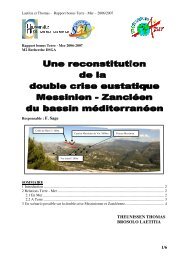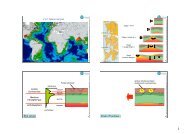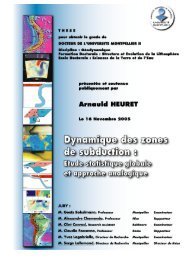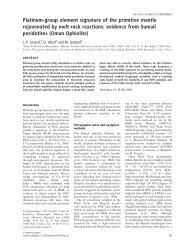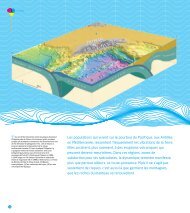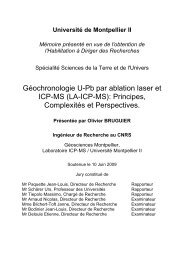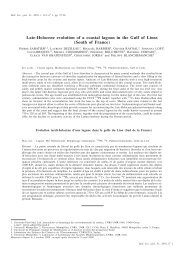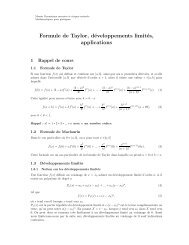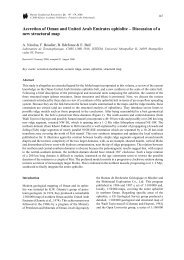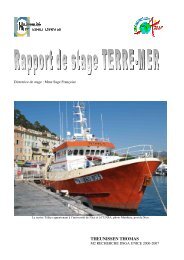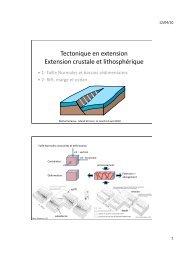B. Henry, J.P. Liégeois, O. Nouar, M.E.M. Derder, B. Bayou, O ...
B. Henry, J.P. Liégeois, O. Nouar, M.E.M. Derder, B. Bayou, O ...
B. Henry, J.P. Liégeois, O. Nouar, M.E.M. Derder, B. Bayou, O ...
You also want an ePaper? Increase the reach of your titles
YUMPU automatically turns print PDFs into web optimized ePapers that Google loves.
426 B. <strong>Henry</strong> et al. / Tectonophysics 474 (2009) 417–434<br />
NNE-SSW Honag shear zone (Fig. 2), the magnetic and visible<br />
foliations and lineations coincide and the magnetic zone axis does not<br />
correspond to the K1 axis (showing that the latter is a mineral<br />
lineation). This is not the case in site TR48, located further from the<br />
shear zone and where the degree of visible deformation is lower. In<br />
the site TR59 in the “undeformed” granite close to the mylonitic zone<br />
plunging 45° toward the SSE, the magnetic foliation shows a plunge<br />
similar to that of the mylonitic zone. In addition the magnetic<br />
foliation is mostly SSE plunging, except close to the Honag shear zone.<br />
The magnetic lineation has a similar orientation in all the sites.<br />
In the Aouzegueur terrane, the contemporaneous Ohergehem pluton<br />
(594±4 Ma) displays most principal axes of the samples relatively well<br />
clustered, within each site as for the whole pluton, for K 1 and for K 3 axes<br />
(Fig. 7A). The mean K1 (D=228°,I=58°) is statistically different (nonoverlapping<br />
confidence zones at 95%) from the magnetic zone axis<br />
(D=297°, I=34° — Fig. 7B). The P′ value varies from 1.021 to 1.556<br />
(mean 1.250), the highest values corresponding to the highest mean<br />
susceptibilities. The T parameter value presents also a large scattering<br />
between −0.81 and 0.73 (mean 0.09). The mean tensor K 3 (D=54°,<br />
I=32°) and K1 axes are very well-defined (Fig. 7B, Table 2). Bootstrap<br />
determination shows that the values for the mean tensor on the P′–T<br />
diagram (P′=1.170, T=0.07) are also well-defined and close to the<br />
mean sample values, confirming the weak scattering of the K 1 and K 3<br />
axes in the samples data. In this pluton, there is a good coincidence<br />
between the magnetic foliation and the foliation determined in the field,<br />
for all the sites where it has been possible to determine it properly. On a<br />
map (Fig. 8A, B), the magnetic foliation and lineation are coherent,<br />
except on the eastern border of the pluton where the visible foliation<br />
also shows a more variable orientation.<br />
5.3. The c. 550 Ma granitoid magmatic suite<br />
On the boundary between Assodé–Issalane and Aouzegueur<br />
terranes, the Adjou pluton has been studied through two cross-<br />
Fig. 7. Maximum (K 1, squares) and minimum (K 3, circles) principal magnetic susceptibility axes of the samples from the Ohergehem (A), Arigher (C), Oued Touffok (E), Honag (G),<br />
Adjou (I — open symbols: northern section, full symbols: southern section), Tin Ghoras (K), Kerkour (M) and Oued Tiririne (O) plutons (stereographic projection in the lower<br />
hemisphere). Confidence zone at 95% from (D, F, H, J, L, N and P) normalized tensor variability (Hext, 1963; Jelinek, 1978) or (B) simple bootstrap (<strong>Henry</strong>, 1997) statistics for the<br />
principal susceptibility axes maximum K1 (squares) and minimum K3 (circles) of the samples from the Ohergehem (B), Arigher (D), Oued Touffok (F), Honag-East (H), Adjou (J), Tin<br />
Ghoras (L), Kerkour (N) and Oued Tiririne (P) plutons (stereographic projection in the lower hemisphere); for the Ohergehem (B) pluton confidence zone at 63 and 95% for the<br />
magnetic zone axis (<strong>Henry</strong>, 1997).



